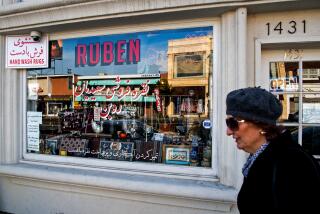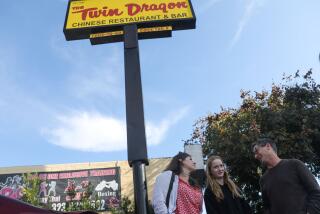Old Faith, New Year : But Even as Zoroastrians Celebrate, They Worry Over Dwindling Numbers
- Share via
WESTMINSTER — About 500 people of Persian descent sang, exchanged hugs and prayed for hours Sunday evening at the California Zoroastrian Center during a celebration of two of the most important events in their ancient religion.
One of the events, Nouruz, the Persian New Year, took place during Wednesday’s vernal equinox; the other celebrates Zarathustra, prophet to the Zoroastrian religion, who is said to have been born 3,764 years ago today.
From throughout Southern California, Zoroastrians gathered at the center to be spiritually cleansed of last year’s sins through a traditional sermon sung by a Zorastrian mobed, or priest.
Flickering in front of mobed Bahram Shahazadi as he sang Sunday was a large bonfire--a symbol of purity in the religion.
The religion, recognized by scholars as a forerunner to several major religions, is facing trouble in a modern world.
Though scholars say the religion influenced the canons of Judaism, Christianity and Islam, the Zoroastrian community has diminished dramatically in size over the centuries.
Where it once thrived as a dominant faith, Zoroastrianism has seen its numbers cut from millions in about 500 B.C. to about 200,000 worldwide today, experts say.
Major causes for the decline, experts say, have been persecution by Arab Muslims when Persia was conquered in the 7th century and the religion’s edict against conversion.
There are about 6,000 Zoroastrians in North America and a few more than 700 in Southern California.
Zoroastrians are either Iranian or Parsi, descendants of Persians who migrated to India during the Arab Muslim takeover.
Most arrived in North America during the late 1970s. Since then, the community has struggled to maintain its size and identity in the face of such pressures as intermarriage and geographic separation.
Zoroastrians in Orange County have attempted to preserve their identity by continuing their 13-day celebration of Nouruz.
In the last nine years, hundreds have convened at the Westminster center to commemorate the new year and to fraternize with seldom-seen friends and relatives.
Since 1981, Zoroastrians and other Persians have also held an all-day outdoor picnic at Irvine’s William R. Mason Regional Park during Sizdeh-Beder, the 13th day of Nouruz.
While old friends kissed each other’s cheeks at the Westminster center in joy of seeing each other again, a troupe of young Zoroastrian children sang and danced to traditional songs on a small stage.
“It’s like a celebration of the community,” said 18-year-old Mehernaz Hamsayeh over the din of a crowded lobby.
*
According to Persian myth, Nouruz, or “New Day,” marks the day the world was created.
For two weeks, the passage of winter’s barrenness into spring’s abundance is celebrated worldwide by Zoroastrians and millions of others of Persian lineage.
In line with what Zarathustra preached to his Persian contemporaries around 1700 B.C., Zoroastrians renew pledges of “goodness” during this period to humanity and to the earth.
The mantra “good thoughts, good words and good deeds,” has been woven into the hearts of Zoroastrians for centuries, through turbulent times and in peace. Concepts of good versus evil and the coming of a savior can be traced to Zoroastrianism.
“Our faith focuses on the good relationship one has with his fellow man, the universe and the creator,” said Dr. Ardeshir Anoshiravani, board member of the Zoroastrian center.
The ultimate achievement, he said, is peace through a sense of equilibrium. “We embrace the world.”
Though such equilibrium is sought by Zoroastrians, the fact that the community is dwindling has caused disruption in U.S. Zoroastrian households lately and has forced some leaders in the ancient religion to seek change.
A tendency for second-generation Zoroastrians to marry outside the religion has stirred a growing debate in the community over whether conversion should be allowed.
Because the religion traditionally does not accept converts, the spouses of Zoroastrians who marry outside of the community are not welcomed at Zoroastrian functions.
Children of mixed marriages have the option of joining the religion when they are 21.
As a result, many Zoroastrians who marry outside will leave the religion altogether, experts say.
Though no accurate figures exist, most Zoroastrian priests and experts agree that it is a growing problem that merits examination of the religion’s attitude toward conversion.
“It’s always at the back of everyone’s mind,” said Aban Commissariat, president of the Zoroastrian Assn. of California in Woodland Hills.
“But very few people will talk about it publicly. It’s a delicate issue for us.”
For 18-year-old Hamsayeh, who was born in Iran but has lived in San Diego most of her life, the issue is a simple one.
“Older generations just don’t embrace the Western world, so there is this tension between the kids and adults,” she said.
As a result, she said there would be trouble in her family if she dated someone outside the religion.
“They need to accept that we have lives here,” said Hamsayeh, a student in San Diego.
*
Rohinton Aresh, who heads Newport Beach’s Traditional Mazdayesni Zoroastrian Assn., said elders in the community are attempting to attract young people.
He said children are mocked at school for wearing traditional Zoroastrian undergarments and belts, which leads them to seek to blend in with the others instead of affirm their identity.
“They need to be made proud of their religion so they won’t want to go outside,” he said.
To increase that pride, various youth education seminars and computer programs have been set up during the last couple of years to garner greater interest in the religion from young Zoroastrians.
“The paradigms are changing. You have to think the American way to get the young interested here,” said Fariborz Shahzadi, one of the religion’s few priests. “It’s good strategy, like a political campaign.”
More to Read
Sign up for Essential California
The most important California stories and recommendations in your inbox every morning.
You may occasionally receive promotional content from the Los Angeles Times.









